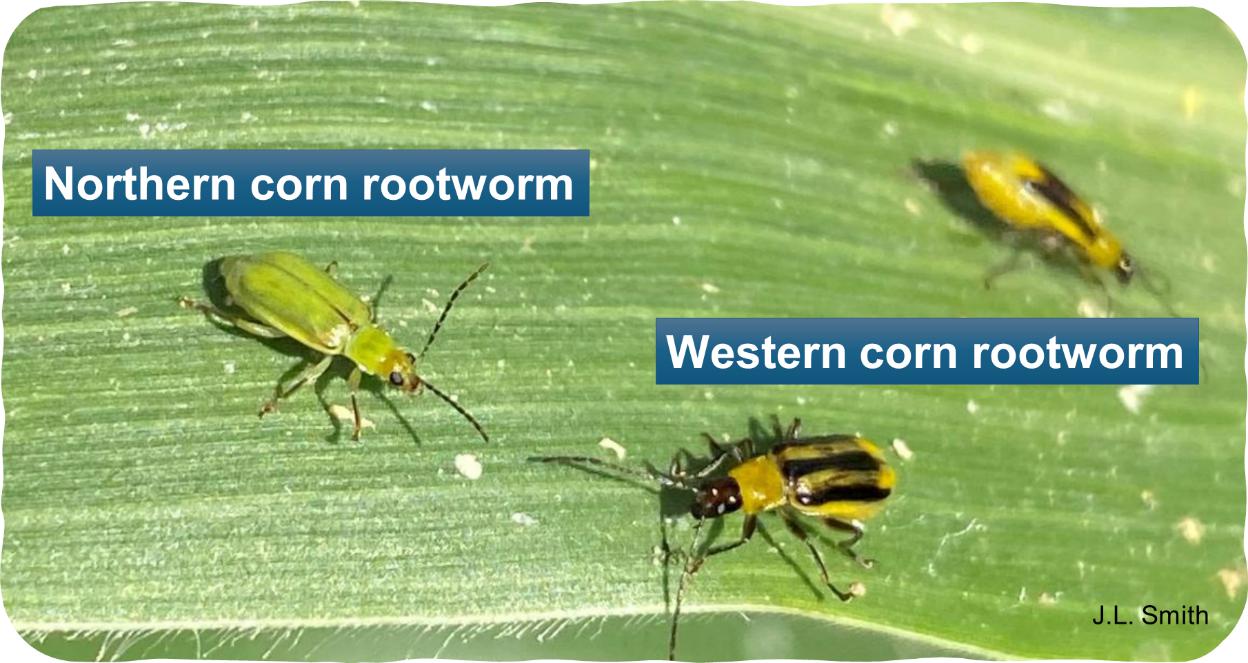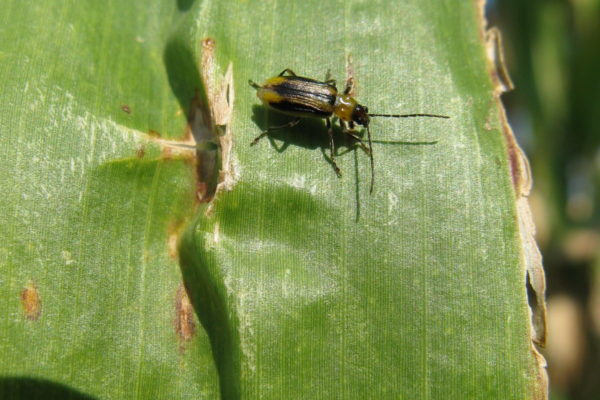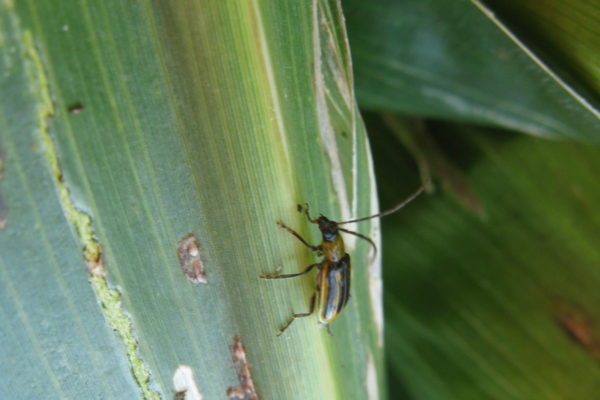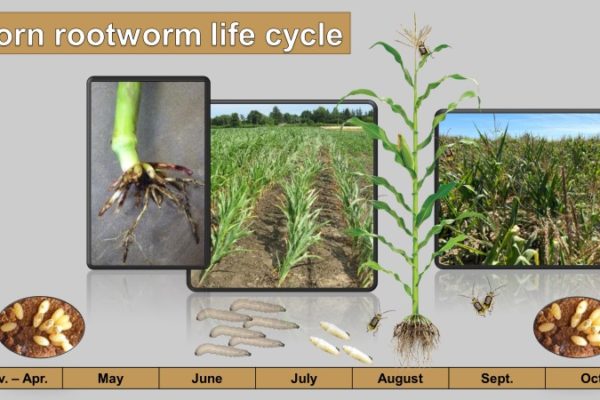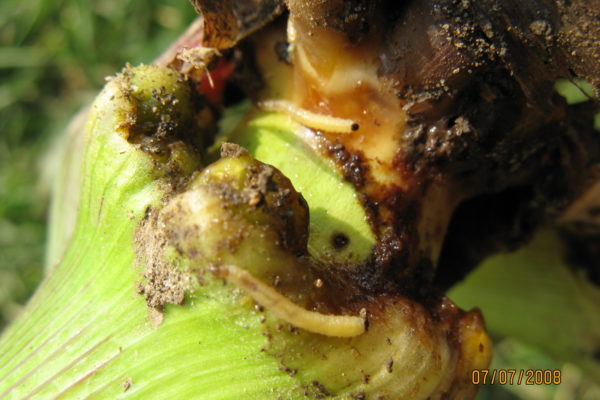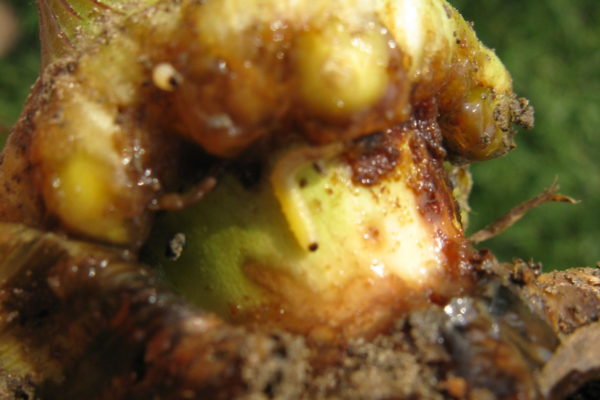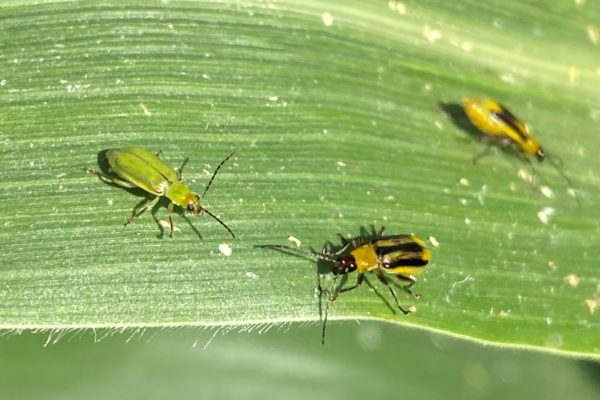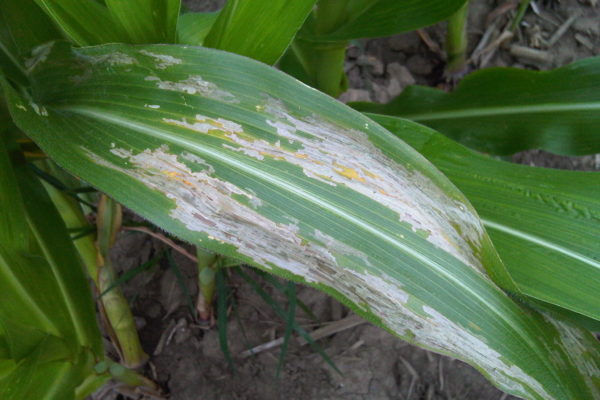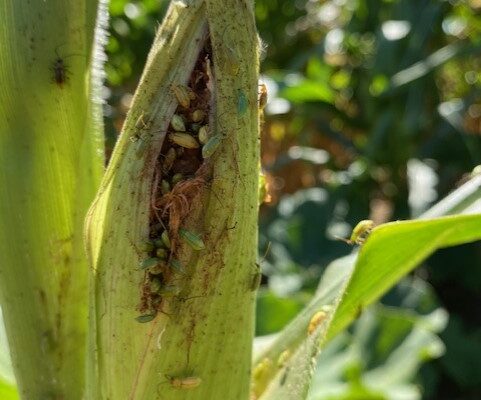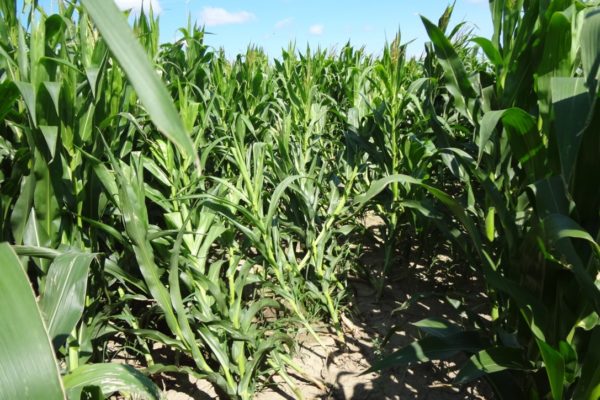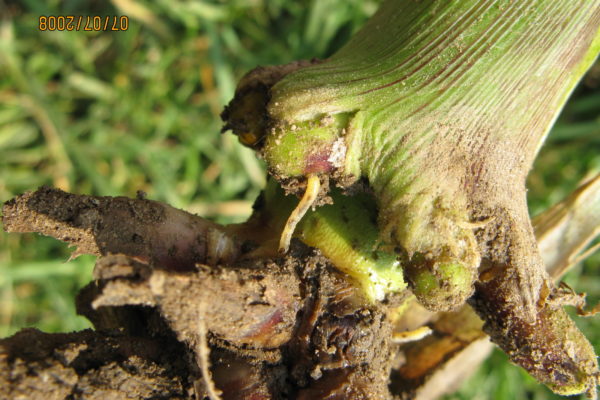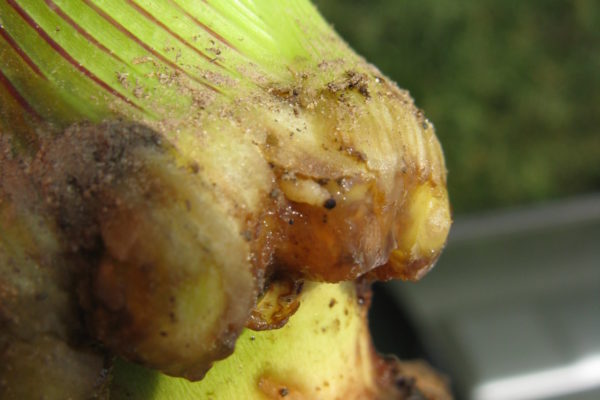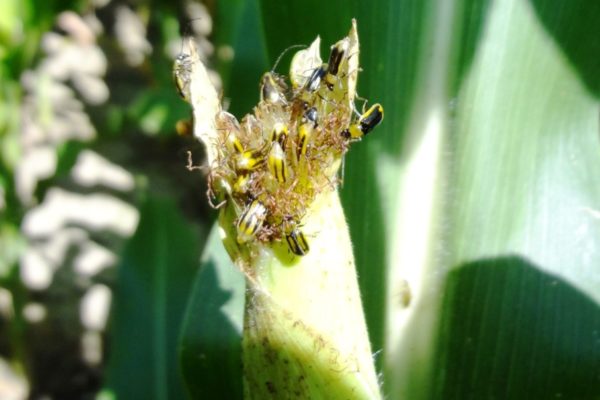Corn rootworm (CRW) (Diabrotica spp.) are beetles that feed on corn as both the adult and larval stage. Larvae feed on corn roots, resulting in lodging, reduced harvestability, and yield loss. CRW have been present in Ontario and Quebec since 1975, spread to Nova Scotia, and were recently detected in British Columbia and Manitoba for the first time in 2016 and 2021, respectively.
Identification
Western corn rootworm (Diabrotica virgifera) beetles are approximately 6 mm in length and are yellow and black. The females typically have three wavy black stripes on their wing covers (elytra) while the three stripes on males are fused and are undifferentiated. Male WCR adults are slightly smaller than the females.
Northern corn rootworm (Diabrotica barberi) adults are also approx. 6 mm long and have light green to dark green elytra, with no stripes or markings.
Corn rootworm larvae are whitish, with a brown head and brown anal plate. Larvae molt three times (=3 instars) and range from 2 to 10 mm long. Though adults feed on corn silk and pollen, it is the larval stage that causes economic injury in corn by feeding on roots.
Distribution
Corn rootworm are found in Ontario, Quebec, Nova Scotia, Manitoba, and British Columbia.
Life Cycle
Both CRW species have one generation per year and overwinter in the egg stage in the soil. In eastern Canada, most eggs hatch between late-May and late-June. Within the larval stage, there are three molting stages called instars. Mature third instars construct an earthen soil cocoon around themselves and transform into an inactive pupa. The pupa matures into an adult beetle and emergence takes place between late-July and the end of September.
Male beetles emerge first and need this extra time to complete sexual development (temperature driven) after which they search for females to mate. Female beetles are usually mated within 24 hours after they emerge from the soil. The female deposits the first egg clutch 11 to 16 days after mating. Females continue feeding to mature more eggs, and another egg clutch is deposited. This process of female feeding, egg maturation and egg-laying is repeated until all eggs have been laid. Female WCR may lay more than 1000 eggs and NCR approximately 300 eggs. Most eggs are laid during August in the top 30 cm of soil.
Click images above to view full image.
Injury to Corn
Once CRW eggs hatch, the first instar larvae are attracted to CO2 and other molecules released by corn roots. Larvae can travel up to 1 m to reach the corn root. Young larvae initially feed on root hairs. Certain sugars exuded by the root stimulate larval feeding. Larvae then tunnel into the cortex region of the primary roots from nodes 1 to 3, causing root scarring. As the corn plant continues to grow and larvae reach the 2nd and 3rd instars, they begin feeding on root tips of nodes 4 to 6. Corn roots typically average 7 to 8 nodes of roots. CRW feeding destroys the growing point at the tips of the roots and stops root elongation. Larvae that continue to feed can prune the root back to the base of the root. Root feeding continues until the larvae reach the pupation stage (late July).
Peak root feeding, i.e. when larvae cause the greatest amount of injury, occurs in July as larvae reach later instars. Root pruning, environmental conditions (e.g. wet soils, high winds) and soil compaction, which hinders root growth, may cause or increase the risk of lodging. Severe root feeding may also occur without the presence of lodging.
Adults feed on corn leaves and then move to silk and pollen as it develops. They can prune the silks back to the ear tip interfering with pollination. Severe clipping damage may cause barren ears. Adult leaf feeding does not cause much yield loss but may create an avenue for secondary pathogens to enter and cause infection.
Click images above to view full image.
Risk Factors
Continuous Corn
The majority of corn rootworm eggs are laid in the same field from which the beetles emerged. If corn is planted in the same field in the following year, corn rootworm larvae will have the necessary host crop to survive. Volunteer corn plants not effectively controlled can also help to support larvae in the absence of a corn crop. If the field is rotated to a non-host crop, such as soybeans or alfalfa, the larvae will starve after hatching.
Soil type
Corn rootworm beetles prefer fine-textured soils such as loams and clays, so they can use soil cracks and earthworm burrows to deposit eggs where soil moisture is adequate. Eggs also require adequate moisture in the spring to hatch. Sandy soils tend to be less prone to CRW injury because sand is abrasive to the eggs and does not retain moisture.
Late-planted corn fields
After laying most of their eggs in the field that they emerged from, CRW adults may eventually move to later planted corn fields that are shedding pollen to lay more eggs. Fields in flower are the most attractive because of the strong scent the corn releases during pollination. Therefore, the latest flowering fields are at a greater risk of being infested which should be considered if being planting with corn in the following year. Rootworm adults may also feed on leaves, flowers, pollen and fruit of other non-corn plants like soybeans, squash, yellow foxtail and other weeds later in the season.
Best Management Practices
Crop Rotation
Because most CRW lay their eggs in corn fields, and the larvae need corn to develop, rotation to a non-corn crop is the most effective and economical control strategy.
Monitoring for lodging in first year corn should still be conducted. In some areas of the U.S. corn belt where vast areas of corn are rotated with soybean in a two-crop rotation, WCR beetles have adapted to laying eggs in non-corn fields (i.e. soybeans, wheat, oats, etc.). Past surveys have not found the rotation-resistant CRW in Canada, but a few first-year corn fields in Ontario have experienced lodging and root pruning due to CRW larvae. The “rotation-resistant” WCR has not been found at economic levels in Canada to date, but this is something to watch for.
Scouting
In some cases, when corn is planted to a second year of corn, CRW protection may not be necessary. CRW adults may not have deposited enough eggs the previous year to cause economic damage. To determine if a control measure is needed in the subsequent corn crop, fields can be scouted once per week in August to count the number of adults present in the ear zone (i.e. 1 leaf below to 1 leaf above the ear node). If the total adult count is on average less than 1 WCR (or 2 NCR) adults per plant in August, then the field will not need a root protection from rootworm (eg. soil applied insecticides or Bt-RW hybrid) following spring (OMAFRA, 2017).
Yellow sticky traps can also be used to monitor adult activity in continuous corn fields to determine potential resistance development and understand the risk level for next year’s corn crop. Four Yellow Non-Baited AM sticky traps can be set up and monitored from mid July to the end of August. Traps need to be checked and replaced weekly for a minimum of six weeks. Two or more beetles per trap per day indicate that the population may be developing resistance to Bt and is at risk of injury the following year if corn is planted again.More information on how to set up and monitor the traps can be found on the Corn Rootworm Adult Trapping Network.
Control options for protection against root injury.
If it is determined that corn rootworm control is needed in corn following corn, the three control options are:
- Planting transgenic corn hybrids expressing a pyramid of proteins for CRW control
- Bt proteins for CRW include: Cry3Bb1, Cry34/35Ab1, mCry3A, eCry3.1Ab*
- *Refer to the Bt trait table to verify whether CRW in your region have developed resistance to any of the proteins
- Neonicotinoid seed treatments at the high rate
- Granular or liquid soil-applied insecticide at planting; refer to provincial recommendations:
British Columbia: https://www2.gov.bc.ca/gov/content/industry/agriservice-bc/production-guides/vegetables/corn
Ontario and Maritimes Provinces: OMAFRA Crop Protection Hub
Quebec: https://www.sagepesticides.qc.ca/
Bt Corn Efficacy CRW and Resistance Status in Canada
| Effective Bt Proteins | Ineffective Bt Proteins | Bt Proteins with Known Resistance |
|---|---|---|
| Cry3Bb1* Cry34/35Ab1* mCry3A* eCry3.1Ab* |
Cross resistance to multiple proteins is suspected in some Ontario populations. Pyramid hybrids may experience injury. Use with best management practices, esp. rotate to non-host crop where high pest pressure is observed. Cry3Bb1 in the US and Ontario Cry34/35Ab1 in the US and Ontario mCry3A in the US and Ontario eCry3.1Ab in the US |
Before 2019, isolated cases of resistance in CRW to some Bt traits for CRW control were observed in Ontario. These instances developed where hybrids expressing only a single Bt trait were planted for many (>3) consecutive years without rotation to other Bt traits or insecticides.
Since 2019, extensive injury to pyramid Bt-rootworm (Bt-RW) hybrids was observed in several counties in Ontario. This level of injury suggests that CRW populations have developed resistance to multiple Bt-RW proteins under continuous corn production practices.
In the US Corn Belt, resistance to Cry3Bb1 was first documented in 2009, often with cross resistance to mCry3A, and this resistance is now widespread in CRW populations in many states. In 2017, isolated cases of resistance to Cry34/35Ab1 were also documented in Iowa. In all cases, the common risk factor associated with resistance is long-term (>3 yr) use of one pest control tool without rotation.
Once resistance has developed to one Bt protein, the effectiveness of a hybrid expressing a pyramid of Bt proteins that include the Bt protein to which resistance has developed is greatly compromised. In this case, the pyramid is now essentially performing as a single Bt protein with greater pest pressure. Due to possible cross-resistance to all available Bt-RW proteins, simply rotating to a different Bt-RW hybrid may not provide control of Bt-resistant CRW. Very few new Bt-RW proteins are in development, so mitigation efforts targeting Bt-resistant CRW populations must be taken immediately to prevent substantial yield loss and feed shortages in the coming years.
Managing Corn Rootworm Resistance to Bt Corn in Continuous Corn Fields
The Canadian Corn Pest Coalition and Crop Life have developed a factsheet on insect resistance management strategies to reduce the risk of rootworm developing resistance to Bt-RW hybrids. This factsheet includes more sustainable rootworm management practices as well as options for those producers dealing with resistant populations. This includes rotating out of corn for one year and growing alternative feed crops or growing crops that rootworm can not survive on.



